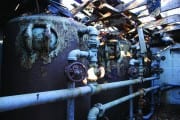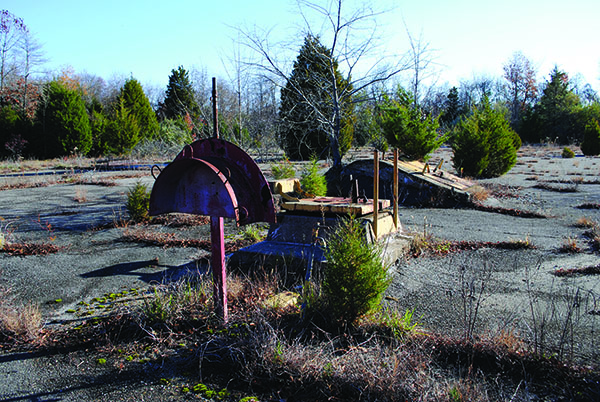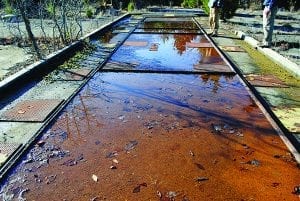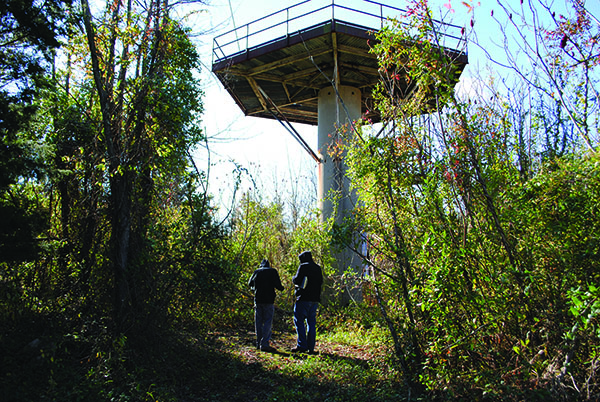In rapid succession last month the United States bombed an airfield in Syria, an ally of Russia’s; sent the “Mother of All Bombs” into an Afghanistan tunnel; deepened investigations into alleged Russian attacks on our election, and opened a game of brinksmanship with North Korea’s nuclear-powered dictator.
Whatever the reasoning and justifications for these actions, the anxiety and warnings expressed by military and political analysts discussing them can be summed in two words: “cold war.” They knew what to call it because we have been here before.
As a matter of fact , and a matter of some irony in fact, Woolwich Township is in the midst of plans to reclaim and reuse a military leftover from the last cold war, the 33 plus-acre Nike Missile Site known officially as PH-58 by the Army, which installed it in the 1950s. It began operation in 1957.
This was the era of the Cold War, capitalized. If you were a child in the 50’s or 60’s you may remember being taught in school to “duck and cover” if the sirens went off. Sirens meant Russia had invaded our airspace and bombs were going to drop. Like the U.S., the USSR (Union of Soviet Socialist Republics, now known as Russia) had nuclear bombs.
 It was the threat of those bombs, and the possible American response, that led the world to hold its collective breath for 13 days in October 1962, when spy planes reported Soviet missile silos in Cuba. It was the time when the Cold War nearly spiraled to terminal heat.
It was the threat of those bombs, and the possible American response, that led the world to hold its collective breath for 13 days in October 1962, when spy planes reported Soviet missile silos in Cuba. It was the time when the Cold War nearly spiraled to terminal heat.
Joseph Musumeci remembers that Cold War. He remembers the duck and cover drills. But more than that, he remembers when the Nike site opened. “I was 10 years old when the soldiers moved in,” he recalled. “They practiced (loading missiles and defensive moves) all the time. The guard dogs would bark. The sirens would go off and you could hear them in Swedesboro a mile away.”

Musumeci remembers, too, how angry his parents, and their next-door neighbors were. “They took our land and the (neighbor’s),” Musumeci said. “We had no choice. The government wanted our land. They (his parents) were told, ‘The site has to be here and you will sell it.’ My parents had to agree to rights of way because they needed a direct line of sight from the administration area on Paulsboro Road to the launch area, which was behind our land.”
The family farmhouse was not taken and is where Musumeci lives with his wife and raised his family. A seed grower, he still farms the remaining land.
He has childhood memories of growing up next to the missile site. “My older brother and I would offer to mow the grass with our tractor. As a reward, the soldiers would invite us over for movie night at the base,” he said.
“We were part of an era where everyone trusted the government and believed the Cold War was Russia’s fault. So when they said (our land) was needed, we believed them. They paid for the land and I don’t recall anybody putting up a fuss, though some people were upset at their property being taken. But, it was our government. And they only took the land. No one lost their house.”
The missile site, built “on one of the highest locations in Gloucester County,” Musumeci said, was one of 14 installed in New Jersey. It was the southernmost defensive position in the state and installed to protect Philadelphia from incoming planes and artillery fire.
Musumeci, who enlisted in the Army and served in Italy at a Nike site with the air defense artillery, was reassigned as a substitute to the Nike site on his home grounds in Woolwich Township. He said the public was not told, but in the site’s later years, it housed Hercules missiles tipped with nuclear warheads.
Such sites, nuclear or not, ringed many major cities back then, ready to respond to any early warning system that screamed an alarm. The Cuban Missile Crisis was defused by diplomacy so narrowly close to explosion that world leaders recognized the near miss. Russia and America stepped back a bit, metaphorically, and by the mid-70s the Cold War had cooled off.
PH-58 was decommissioned and abandoned in 1974. The Army Corps of Engineers over the next years cleaned out the site, covered the three 30-ft deep missile silos and left the buildings, including the dog houses, in place. Over the years it became a target for urban explorer hobbyists, who would post online photos of their adventures.
This was, and is, a dangerous pastime, however, said Matthew Blake, Director of Community Development for Woolwich Township. “The launch site is riddled with dilapidated buildings and poison ivy, high fences and barbed wire. Think King Kong behind a wall, and stay out,” he said. “We strongly discourage people from going there.”
Blake gets to say this because in 2009 the township paid $828,000 to the federal government to purchase the 14-acre administrative section of the land along Swedesboro-Paulsboro Rd.
The Nike site is divided into two sections, the administrative area where military personnel worked, and the launch area, about 20 acres, where the missiles and necessary equipment were lodged. Woolwich did not purchase the launch area. It was deeded over free to the township “in return for an easement restricting any future development of that area to conservation, open space and/or park purposes,” Blake explained.

That site is where the broke-down buildings, “water and snake-filled silos,” and poison ivy tangles are, “and it will cost hundreds of thousands of dollars to clean up for use,” Blake said. It is likely that those 20 acres will remain as is for now, he added, perhaps “as a wildlife refuge.”
He said he had no idea if there were nuclear warheads at the launch area, or if the Army Corps of Engineers cleaned for radiation materials before declaring their job done. For now, Blake said, those 20 acres will lie as is.
But the township has major expectations for the administrative parcel, Blake enthused. “The Army looked to put these sites into low population areas and we were a very rural, small farm community back then. We were the tomato capital of New Jersey,” he said. “Then in the early 90s, until the 2007 recession, we were one of the fastest growing areas on the East Coast. Now we’re at a crossroads.”

The township sees the Nike site, which is still undergoing “due diligence, testing water quality and such,” as a perfect fit for the Master Plan adopted last year, after some “dedicated work” by Mayor Alan Schwager, Blake said. The plan includes a commercial corridor in the area’s regional center, according to Blake. “Redevelopment of the site is a means of remediating it,” he said.
To that end, Blake said the township is seeking public and private partners with ideas for developing the 14-acre section. “We’re the last frontier, the largest undeveloped site in the state near a turnpike interchange, the last exit on the turnpike ripe for development. It’s a balancing act. We want growth management and aggressive preservation of farmland.
“The radar towers are in remarkably good condition,” he pointed out, “and can be seen from the (Commodore Barry) bridge and the roadway. I can imagine a sign on a 60-foot tower for a micro-brewery or something,” he suggested.
His ruminations travel in the “light industrial” pathway, but could include a go-cart or amusement park, a brewery, horse (or 4-wheeler) trails. “We’re looking for proposals that meet our (plans), and we don’t need to sell the land, we can lease it,” he said.
Among the lofty and forward-looking expectations, Blake agreed there also might be an area set aside to honor the 100 or so soldiers who manned the “last line of defense” 24-7 in what many these days are hoping was the nation’s last Cold War.
By Jean Redstone












One Response
I was stationed at PH58 Swedesboro 12/60 to 3/63.